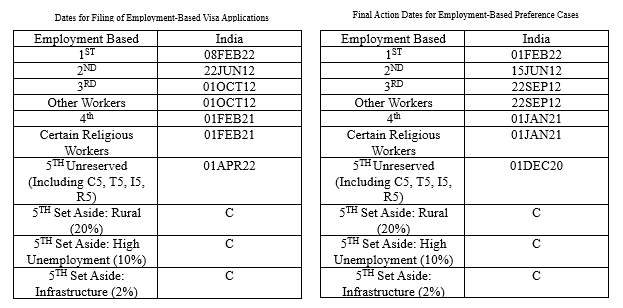July 2024 Visa Bulletin: Visa dates experience major movement for India
There have been quite a few substantial movements for India within various employment-based categories this month.

The U.S. Department of State (DOS) publishes current immigrant visa availability information on its Visa Bulletin. The Visa Bulletin shows when immigrant visas are available for issuance to prospective immigrants based on their individual priority dates. Every month, the DOS publishes two charts per visa preference category on its Visa Bulletin. The charts are based on the Application Final Dates and Dates for Filing Applications.
The Application Final Dates chart illustrates the dates when visas may finally be issued, and the Dates for Filing Applications demonstrates the earliest dates when applicants may be able to apply.
For the July 2024 Visa Bulletin, USCIS has decided that it will continue to use the Final Action Dates for Employment-Based Adjustment of Status Applications table. Meanwhile, USCIS also decided to continue to follow the Dates for Filing for Family-Sponsored Adjustment of Status Applications table. While the July 2024 visa bulletin demonstrates movement dates for individuals across the globe, this article will specifically focus on the dates that impact Indian nationals.
.png) Family-Sponsored Preference Cases Specific for Indian Nationals / USCIS
Family-Sponsored Preference Cases Specific for Indian Nationals / USCIS-
Family-based First Preference Category (F-1 – Unmarried Sons and Daughters of U.S. Citizens): India’s visa cut-off date will remain on September 1, 2017.
-
Family-based Second Preference Category (F2A – Spouses and Children of Permanent Residents): India’s visa cut-off date advanced further than illustrated in previous visa bulletins by a few months to November 1, 2023.
-
Family-based Second Preference Category (F2B – Unmarried Sons and Daughters (21 years of age or older) of Permanent Residents: India’s visa cut-off date will remain on January 1, 2017
-
Family-based Third Preference Category (F3 – Married Sons and Daughters of U.S. Citizens): India’s visa cut-off date advances to October 1, 2010.
-
Family-based Fourth Preference Category (F4 – Brothers and Sisters of Adult U.S. Citizens): India’s visa cut-off date will remain the same on June 15, 2006.
 Employment-Sponsored Preference Cases Specific for Indian Nationals / USCIS
Employment-Sponsored Preference Cases Specific for Indian Nationals / USCIS
-
Employment-based First (Priority Workers): India’s visa cut-off moves up significantly to February 1, 2022.
-
Employment-based Second (Members of the Professions Holding Advanced Degrees or Persons of Exceptional Ability): India’s visa cut-off date also advances to June 15, 2012.
-
Employment-based Third (Skilled Workers, Professionals, and Other Workers): India’s visa cut-off date advances by a month to September 22, 1012
-
Employment-based Fourth (Certain Special Immigrants – including Religious Workers): India’s visa cut-off date also advances by a significant number of months to January 1, 2021.
-
Employment-based Fifth (Employment Creation – which is the EB-5 immigrant investor visa category): In the Unreserved category, EB-5 visa availability date remains on December 1, 2020, for India. Finally, in the Final Action Dates chart for EB5 Set Asides (which covers Rural, and High Unemployment, and Infrastructure areas) for Indian born applicants, the visa number continue to remain ‘Current.
As readers can see from the description provided, there have been many significant developments from prior months’ Visa Bulletin, as most of the filing dates have advanced by at least a few months.
Moreover, by using the Final Action Dates for Employment-based Preference Cases in the July 2024 monthly visa bulletin, U.S. Department of State is signaling that it is doing all it can to hold in check the visa numbers for the employment-based preference categories while it faces great demand for these visa preference categories on all levels.
That is also why it was encouraging to see quite a few substantial movements for India within various employment-based categories this month. We will continue to observe the steps taken by the Department of State and USCIS in the coming months.
Clement C. Chang Esq is a Senior Associate at Pasricha & Patel, LLC. He has spent several years providing exceptional legal services in employment-based immigration, labor certification, family-based immigration, and immigrant and nonimmigrant visa petitions. Visit Pasricha & Patel, LLC’s website here: www.pasricha.com





.jpg)
.jpg)
.png)
.png)

.png)

.png)
.jpg)

Comments
Start the conversation
Become a member of New India Abroad to start commenting.
Sign Up Now
Already have an account? Login